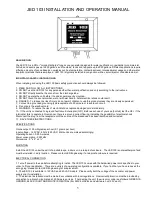
3. Press the encoder to open the routing. The cursor will highlight the first available channel block.
4. Either rotate the encoder to select the next available channel block or press it to start assigning the
source signal.
5. Again, rotate the encoder to select the source for the selected output.
Choosing "unrouted" deletes an existing routing, and "cancel" aborts the routing and keeps the
previous routing.
At single speed MADI, a consecutive routing of the first channels 1-32 and following
channels 33-64 can be created in one step. By continuing to rotate the encoder on the
output channel block field, those two ranges are followed by a finer granularity of four
channels. Those are then displayed as "Channel 1-4", "Channel 5-8", etc.
To create a routing to a MADI output on the web remote:
1. Click the MADI coaxial or MADI optical output port.
2. Select and click a block of four channels by clicking it. The channels will be highlighted in blue.
3. Open any input port and click a block of four channels. A routing is created and displayed with a
connection line.
10.2.3. MADI Daisy Chains
MADI is a uni-directional protocol with a fixed number of channels. When more than two MADI devices
are connected, a serial connection is required. This is also referred to as a "daisy chain". The output of
the first device is connected to the input of the second device, the output of the second device to the
input of third device, and so on, until the signal is plugged into the input of the first device.
It is important to understand that each device must be programmed to pass on audio from its MADI
input to the MADI output. Otherwise, the last device would only receive the channels of one device.
While many RME devices pass on MADI signals automatically, the M-32 DA Pro must be
explicitly configured to do so.
In order to pass on signals, configure the output routing of the required output port to pass on the signal
from the MADI input port.
The latency of the MADI I/O is four samples.
10.2.4. MADI Port Mirroring
A redundant MADI connection protects from loss of audio in case of a single cable failure. To achieve
redundancy, the receiver must support MADI redundancy. The sender must send two identical MADI
signals on two outputs, usually the BNC coaxial and SC optical ports.
The M-32 DA Pro features independent routing for both MADI output ports. For this reason, a "mirroring"
of the signal must be manually created. In order to do this, the routing of the two MADI outputs should
be configured to contain the same routing.
The receiving device usually ignores the audio contents of the two MADI signals.
Therefore, the redundancy may appear to be set up even though the M-32 DA Pro sends
different audio signals on both ports.
RME M-32 DA Pro User’s Guide
10.2. MADI Outputs |
42
Содержание M-32 MIDI DA Pro
Страница 2: ...RME M 32 DA Pro User s Guide...















































